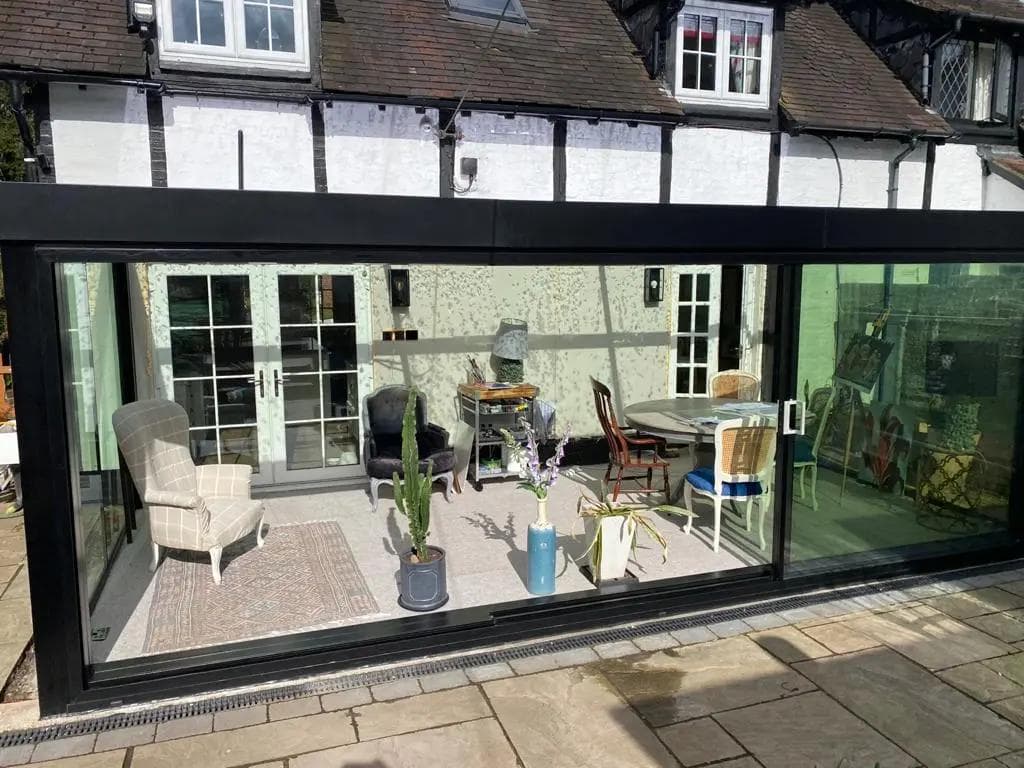How Does a Glass Extension Compare to a Traditional Home Extension?
When it comes to expanding your living space, the choice often comes down to two main options: a glass extension or a traditional brick-and-mortar extension. Both can completely transform your home.

1. Aesthetic Appeal: Contemporary Style vs Classic Continuity
One of the most obvious differences between a glass extension and a traditional one is their visual impact.
Glass Extensions – Light, Modern, and Sleek
Glass extensions are all about style and light. They blur the lines between indoors and outdoors, flooding your home with natural daylight and creating a stunning architectural feature. The transparent walls offer panoramic garden views and make even modest spaces feel larger and more open.
If you’re after a wow factor — something that feels luxurious, modern, and unique — a glass extension delivers exactly that.
Traditional Extensions – Seamless and Subtle
A brick-built extension is designed to blend in. It uses similar materials and finishes to your existing property, making it feel like a natural continuation of your home. If your goal is to maintain a consistent architectural style — especially with period properties — this might be the safer route.
Verdict: Glass wins for modern aesthetics and light. Traditional wins for classic continuity and seamless integration.
2. Natural Light and Connection to the Outdoors
This is where glass extensions truly shine.
Glass Extensions – Bringing the Outside In
With floor-to-ceiling glazing, your new space becomes a sun-drenched retreat. Whether it’s a kitchen, dining room, or garden room, the abundance of natural light can boost mood, reduce reliance on artificial lighting, and improve energy efficiency. Plus, the strong visual connection to the outdoors creates a feeling of space that brick walls simply can’t match.
Traditional Extensions – More Enclosed and Private
Traditional extensions often include standard-sized windows and doors, providing less natural light and a more enclosed feel. While this can create a cozier, more private atmosphere, it lacks the bright, airy ambiance a glass structure offers.
Verdict: Glass is the clear winner for natural light and a seamless indoor-outdoor feel.
3. Energy Efficiency and Comfort
It’s a common misconception that glass extensions are cold in winter and hot in summer — but thanks to modern glazing technology, that’s no longer the case.
Glass Extensions – Smart Glazing for Year-Round Comfort
High-performance double or triple glazing, solar-control coatings, and thermal breaks mean today’s glass extensions can be highly energy-efficient. They retain warmth in winter, reduce overheating in summer, and can even help cut down on heating bills if designed correctly.
Traditional Extensions – Naturally Insulated
Traditional builds naturally offer strong insulation with brick and cavity wall construction, and are usually more straightforward to regulate in terms of temperature. However, they don’t offer the same passive solar benefits as a well-designed glass room.
Verdict: Both can be energy-efficient — but glass technology has closed the gap significantly in recent years.
4. Cost, Build Time, and Planning Permission
The practical side of any extension project is just as important as the aesthetics.
Glass Extensions – Premium Price, Quicker Installation
A glass extension often comes with a higher upfront cost per square metre due to the specialist materials and structural engineering involved. However, they’re typically faster to install and involve less disruption, as many elements are prefabricated off-site.
Planning permission is usually straightforward, but you’ll need to check local rules — particularly if your property is listed or in a conservation area.
Traditional Extensions – Variable Costs, Longer Projects
A brick-and-mortar extension can be cheaper initially, but costs can escalate with complex design elements, plumbing, or roofing work. Build times are often longer, involving more trades and groundwork. Planning permission can also be more involved depending on the scale of the project.
Verdict: Glass extensions are often quicker but pricier. Traditional builds may be cheaper but usually take longer.
5. Flexibility and Functionality
Finally, consider how you plan to use the space.
Glass Extensions – Perfect for Living Spaces
Glass extensions excel as kitchens, dining areas, lounges, or garden rooms — anywhere where light and atmosphere matter most. However, they may require thoughtful design for privacy or storage.
Traditional Extensions – Greater Versatility
Traditional extensions can be adapted for any purpose, from extra bedrooms to home offices, utility rooms, or even full two-storey additions. Their solid walls make it easier to add electrics, insulation, or built-in furniture.
Verdict: Traditional builds are more versatile, while glass shines in social, lifestyle-focused spaces.
Final Thoughts: Which Is Right for You?
There’s no one-size-fits-all answer — your ideal choice depends on your budget, property style, and lifestyle goals.
- Choose a glass extension if you want a bold, contemporary feature that floods your home with light and blurs the boundary between inside and out.
- Choose a traditional extension if you’re after seamless integration, versatility, and a classic look that feels like it’s always been part of your home.
In many cases, a hybrid approach — combining brickwork with large glazed panels — offers the best of both worlds. Whatever you choose, both options can add significant value, space, and beauty to your home.
Related Content
Discover more content related to this blog

The Rise of Glass Rooms in the UK — Why They’re Becoming the Must-Have Home Upgrade
In recent years, glass rooms have rapidly evolved from a luxury addition to a mainstream aspiration for UK homeowners.

How much does a Glass Box Extension Cost
Adding a glass box extension is one of the most effective ways to transform your home — both visually and functionally. These striking, contemporary structures flood interiors with natural light, connect living spaces to the outdoors, and add significant value to your property.

Glulam Frame Glass Box Extension
📍 Derbyshire

Sugar Hill
📍 West Lancashire

Glass Box
📍 Cumbria

Glass Box Extension
📍 Peak District